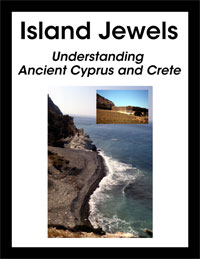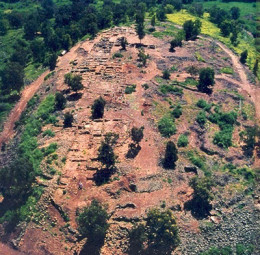Crete’s Minoan civilization has long been considered Europe’s first great Bronze Age society. But who were the Minoans? A recent DNA study suggests that the Minoan civilization comprised of local Europeans rather than outsiders. The post Who Were the...
This Bible History Daily article was originally published in May 2013. It has been updated.—Ed.

Who were the Minoans? The Minoan civilization is remembered for its ornate frescoes, including this Prince of the Lillies from the palace at Knossos.
Who were the Minoans? Their civilization in Crete has long been considered Europe’s first great Bronze Age society. The floruit of the Minoan civilization, which spread across Crete in the third millennium B.C.E., occurred in the 18th–16th centuries B.C.E., in the late Middle Bronze Age and the start of the Late Bronze Age. The island is dotted with magnificent palaces, including labyrinthine Knossos, Phaistos and Mallia, and Minoan art and traditions have captivated and influenced the Mediterranean world for thousands of years.
Despite their celebrated legacy, the Minoan civilization remains shrouded in mystery. We do not know what language was spoken on Crete, and the scripts of the early Minoan civilization—Cretan Hieroglyphs and Linear A—have eluded translation attempts for over a century. Despite extensive archaeological research exploring the history of Crete, the Minoan civilization has always kept close ties to the world of mythology. Sir Arthur Evans, the first person to carry out extensive excavations in Crete, named the society after the mythological king Minos. Crete’s landscape serves as the setting for countless legends, including the birthplace of Zeus, the labyrinth where Theseus killed the Minotaur and the prison that Deadalus and Icarus fled with their ill-fated wings.
But who were the people that left us with such grand mysteries and ornate palaces?
Become a Member of Biblical Archaeology Society Now and Get More Than Half Off the Regular Price of the All-Access Pass!
Explore the world’s most intriguing Biblical scholarship
Dig into more than 9,000 articles in the Biblical Archaeology Society’s vast library plus much more with an All-Access pass.

Sir Arthur Evans claimed that the ancestors of the Minoan civilization came from North Africa, but more recent scholars have suggested dozens of additional forefathers. On May 14, 2013, Nature Communications published the study “A European population in Minoan Bronze Age Crete,” analyzing mitochondrial DNA from Minoan osseous tissue found in caves at the Cretan Lassithi plateau. It suggests that the Minoan civilization was comprised of local Europeans rather than outsiders. The Greek and American research team writes that “Our data are compatible with the hypothesis of an autochthonous development of the Minoan civilization by the descendants of the Neolithic settlers of the island” and that “shared haplotypes, principal component and pairwise distance analyses refute the Evans North African hypothesis.”

FREE ebook: Island Jewels: Understanding Ancient Cyprus and Crete. Read the fascinating history of these mythical Mediterranean islands.

Who were the Minoans? Knossos’s Ladies in Blue are genetically related to modern Europeans, according to a recent DNA study. Archaeological Museum of Iraklion.
The researchers examined over 100 bone samples from the third and second millennia B.C.E. and found a combination of distinctly European and uniquely Minoan characteristics—with no trace of African descent. The DNA samples are consistent with that of Neolithic, Bronze Age and modern European populations, especially Crete’s modern population. The Minoan people may be related to groups that migrated from Anatolia millennia earlier; if true, this would allow researchers to use cues from known Indo-European languages to help decipher the still-unknown language of the Minoan civilization.
While mysteries about the seafaring Minoan civilization remain, we are one step closer to answering the question: Who were the Minoans? As University of Washington geneticist George Stamatoyannopoulos says, “We now know that the founders of the first advanced European civilization were European.”
Read “A European population in Minoan Bronze Age Crete” in Nature Communications.
Related reading in Bible History Daily:
Phaistos Disk Deciphered? Not Likely, Say Scholars
Bronze Age Collapse: Pollen Study Highlights Late Bronze Age Drought
Early Bronze Age: Megiddo’s Great Temple and the Birth of Urban Culture in the Levant
What Does the Aegean World Have to Do with the Biblical World?
Read more about Minoan civilization in the BAS Library:
The Minoans of Crete: Europe’s Oldest Civilization: Excavating Minoan Sites
Past Perfect: In Pursuit of Minoan Crete
Not a BAS Library or All-Access Member yet? Join today.Get more biblical Archaeology: Become a Member
The world of the Bible is knowable. We can learn about the society where the ancient Israelites, and later Jesus and the Apostles, lived through the modern discoveries that provide us clues.
Biblical Archaeology Review is the guide on that fascinating journey. Here is your ticket to join us as we discover more and more about the biblical world and its people.
Each issue of Biblical Archaeology Review features lavishly illustrated and easy-to-understand articles such as:
• Fascinating finds from the Hebrew Bible and New Testament periods
• The latest scholarship by the world's greatest archaeologists and distinguished scholars
• Stunning color photographs, informative maps, and diagrams
• BAR's unique departments
• Reviews of the latest books on biblical archaeology
The BAS Digital Library includes:
• 45+ years of Biblical Archaeology Review
• 20+ years of Bible Review online, providing critical interpretations of biblical texts
• 8 years of Archaeology Odyssey online, exploring the ancient roots of the Western world in a scholarly and entertaining way,
• The New Encyclopedia of Archaeological Excavations in the Holy Land
• Video lectures from world-renowned experts.
• Access to 50+ curated Special Collections,
• Four highly acclaimed books, published in conjunction with the Smithsonian Institution: Aspects of Monotheism, Feminist Approaches to the Bible, The Rise of Ancient Israel and The Search for Jesus.
The All-Access membership pass is the way to get to know the Bible through biblical archaeology.
The post Who Were the Minoans? appeared first on Biblical Archaeology Society.












